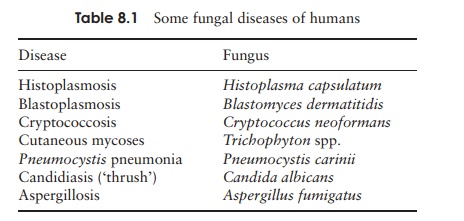Chapter: Essential Microbiology: Fungi
Fungi and disease
Fungi and
disease
A limited number of fungi are pathogenic to humans
(Table 8.1). Mycoses (sing: mycosis)
in humans may be cutaneous, or systemic; in the latter, spores generally enter
the body by inhalation, but subsequently spread to other organ systems via the
blood, causing serious, even fatal disease.

Cutaneous mycoses are the
most common fungal infections found in humans, andare caused by fungi known as dermatophytes, which are able to utilise
the keratin of skin, hair or nails by secreting the enzyme keratinase. Popular names for such infections include ringworm and
athletes’ foot. They are highly contagious, but not usually serious conditions.
Systemic mycoses can be
much more serious, and include conditions such as histo-plasmosis and
blastomycosis. The former is caused by Histoplasma
capsulatum, and is associated with areas where there is contamination by
bat or bird excrement. It is thought that the number of people displaying
clinical symptoms of histoplasmosis rep-resents only a small proportion of the
total number infected. If confined to the lungs, the condition is generally
self-limiting, but if disseminated to other parts of the body such as the heart
or central nervous system, it can be fatal. The causative agents of both
diseases exhibit dimorphism; they exist in the environment as mycelia but
convert to yeast at the higher temperature of their human host.
Aspergillus
fumigatus is an example of an opportunistic pathogen, that is, an or-ganism which, although
usually harmless, can act as a pathogen in individuals whose resistance to
infection has been lowered. Other opportunistic mycoses include candidi-asis
(‘thrush’) and Pneumocystis
pneumonia. The latter is found in a high percentage of acquired immune
deficiency syndrome (AIDS) patients, whose immune defences have been
compromised. The causative organism, Pneumocystis
carinii, was previously con-sidered to be a protozoan, and has only been
classed as a fungus in the last decade, as a result of DNA/RNA sequence
evidence. It lives as a commensal in a variety of mammals, and is probably
transmitted to humans through contact with dogs.
The incidence of opportunistic mycoses has increased
greatly since the introduction of antibiotics, immunosuppressants and cytotoxic
drugs. Each of these either suppresses the individual’s natural defences, or
eliminates harmless microbial competitors, allowing the fungal species to
flourish.
Many fungi produce natural mycotoxins; these are secondary
metabolites, which, if consumed by humans,can cause food poisoning that can
sometimes be fatal. Certain species of mushrooms (‘toadstools’) including the
genus Amanita contain substances that
are highly poisonous to humans. Other examples of mycotoxin ill-nesses include
ergotism and aflatoxin poi-soning. Aflatoxins are carcinogenic toxins produced by Aspergillus
flavus that grows on stored peanuts. In theearly 1960s, the turkey industry
in the UK was almost crippled by ‘Turkey X disease’, caused by the consump-tion
of feed contaminated by A. flavus.
It is thought likely that all animals are parasitised
by one fungus or another. Extraordinary though it may seem, there are even
fungi that act as predators on small soil animals such as nematode worms,
producing constrictive hyphal loops that tighten, immobilising the prey.
Fungi also cause disease in plants, and can have a
devastating effect on crops of economic importance, either on the living plant
or in storage subsequent to harvest-ing. Rusts, smuts and mildews are all
examples of common plant diseases caused by fungi. The effects of fungi on
materials such as wood and textiles.
Related Topics